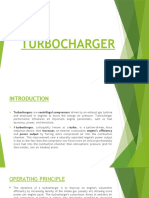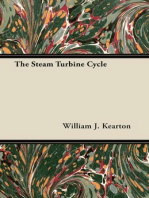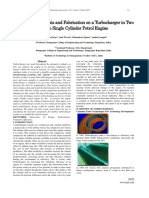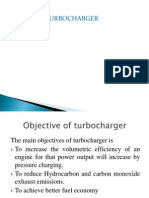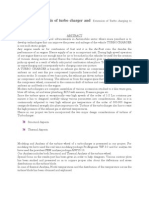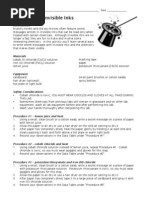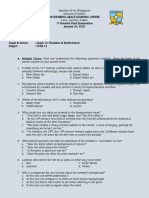0 ratings0% found this document useful (0 votes)
8 viewsUnit II - Turbo Super Charger
Unit II - Turbo Super Charger
Uploaded by
drkbalaTurbochargers use exhaust gases to spin a turbine that drives an air compressor, forcing more air into the engine to increase power. There are two main types - wastegate turbochargers which bypass excess exhaust to control boost pressure, and variable geometry turbochargers which adjust exhaust nozzle angles. Intercoolers cool the compressed intake air to increase density. However, turbochargers suffer from initial lag as the turbine spins up before providing their power boost.
Copyright:
© All Rights Reserved
Available Formats
Download as PDF, TXT or read online from Scribd
Unit II - Turbo Super Charger
Unit II - Turbo Super Charger
Uploaded by
drkbala0 ratings0% found this document useful (0 votes)
8 views14 pagesTurbochargers use exhaust gases to spin a turbine that drives an air compressor, forcing more air into the engine to increase power. There are two main types - wastegate turbochargers which bypass excess exhaust to control boost pressure, and variable geometry turbochargers which adjust exhaust nozzle angles. Intercoolers cool the compressed intake air to increase density. However, turbochargers suffer from initial lag as the turbine spins up before providing their power boost.
Original Title
Unit II_Turbo super charger
Copyright
© © All Rights Reserved
Available Formats
PDF, TXT or read online from Scribd
Share this document
Did you find this document useful?
Is this content inappropriate?
Turbochargers use exhaust gases to spin a turbine that drives an air compressor, forcing more air into the engine to increase power. There are two main types - wastegate turbochargers which bypass excess exhaust to control boost pressure, and variable geometry turbochargers which adjust exhaust nozzle angles. Intercoolers cool the compressed intake air to increase density. However, turbochargers suffer from initial lag as the turbine spins up before providing their power boost.
Copyright:
© All Rights Reserved
Available Formats
Download as PDF, TXT or read online from Scribd
Download as pdf or txt
0 ratings0% found this document useful (0 votes)
8 views14 pagesUnit II - Turbo Super Charger
Unit II - Turbo Super Charger
Uploaded by
drkbalaTurbochargers use exhaust gases to spin a turbine that drives an air compressor, forcing more air into the engine to increase power. There are two main types - wastegate turbochargers which bypass excess exhaust to control boost pressure, and variable geometry turbochargers which adjust exhaust nozzle angles. Intercoolers cool the compressed intake air to increase density. However, turbochargers suffer from initial lag as the turbine spins up before providing their power boost.
Copyright:
© All Rights Reserved
Available Formats
Download as PDF, TXT or read online from Scribd
Download as pdf or txt
You are on page 1of 14
Turbo super charger
Dr.K.BALAMURUGAN, ASP/MECH, IRTT, Erode
Super charger and Turbo Super Chargers
A supercharger is an air compressor used to increase
the pressure, temperature, and density of air supplied to
an internal combustion engine.
Power for the supercharger can be provided mechanically
by a belt, gear, shaft, or chain connected to the
engine's crankshaft.
When power is provided by a turbine powered
by exhaust gas, a supercharger is known as
a turbosupercharger – typically referred to simply as
a turbocharger or just turbo.
Turbo super charger
A turbocharger, or turbo (mixing/spinning) is a forced
induction device used to allow more power to be
produced for an engine of a given size.
A turbocharged engine can be more powerful and
efficient than a naturally aspirated engine because the
turbine forces more intake air, proportionately more fuel,
into the combustion chamber than if atmospheric
pressure alone is used.
Turbos are commonly used on truck, car, train, and
construction equipment engines. Turbos are popularly
used with Otto cycle and Diesel cycle internal
combustion engines.
Turbo charger - Operating principle
In most piston engines, intake gases are "pulled" into the
engine by the downward stroke of the piston (which creates a
low-pressure area), similar to drawing liquid using a syringe.
The amount of air which is actually inhaled, compared with the
theoretical amount if the engine could maintain atmospheric
pressure, is called volumetric efficiency.
The objective of a turbocharger is to improve an engine's
volumetric efficiency by increasing density of the intake gas
(usually air).
The turbocharger's compressor draws in ambient air and
compresses it before it enters into the intake manifold at
increased pressure. This results in a greater mass of air
entering the cylinders on each intake stroke. The power
needed to spin the centrifugal compressor is derived from the
kinetic energy of the engine's exhaust gases.
Turbo charger - Operating principle
A turbocharger may also be used to increase fuel
efficiency without increasing power. This is achieved by
recovering waste energy in the exhaust and feeding it
back into the engine intake.
By using this otherwise wasted energy to increase the
mass of air, it becomes easier to ensure that all fuel is
burned before being vented at the start of the exhaust
stage. The increased temperature from the higher
pressure gives a higher Carnot efficiency.
Turbo charger - Operating principle
Intercooling
When the pressure of the engine's intake air is increased, its
temperature will also increase. In addition, heat soak from the
hot exhaust gases spinning the turbine may also heat the
intake air. The warmer the intake air the less dense, and the
less oxygen available for the combustion event, which reduces
volumetric efficiency. Not only does excessive intake-air
temperature reduce efficiency, it also leads to engine knock,
or detonation, which is destructive to engines.
Turbocharger units often make use of an intercooler (also
known as a charge air cooler), to cool down the intake air.
Intercoolers are often tested for leaks during routine servicing,
particularly in trucks where a leaking intercooler can result in
a 20% reduction in fuel economy.
Intercooling
Intercooling
Type 1 : Waste Gate Turbocharger
Most automotive turbochargers have a wastegate, which
allows the use of a smaller turbocharger to reduce lag
while preventing it from spinning too much.
The wastegate senses the boost pressure and if the
pressure gets too high, it could be an indicator that the
turbine is spinning too quickly, so the wastegate bypasses
some of the exhaust around the turbine blades, allowing
the blades to slow down to proper speed.
Type 1 : Waste Gate Turbocharger
Type 2 : Variable geometry turbocharger
A Variable Turbine Geometry turbocharger is also known
as a variable geometry turbocharger (VGT), or a
Variable Nozzle Turbine (VNT).
A turbocharger equipped with Variable Turbine Geometry
has little movable vanes which can direct exhaust flow
onto the turbine blades.
The vane angles are adjusted via an actuator.
Type 2 : Variable geometry turbocharger
Turbo Lag
One of the main problems with turbochargers is that
they do not provide an immediate power boost when you
“pedal to the metal”.
It takes a second or two for the turbine to get up to
speed before full pumping of the air is produced.
This results in a feeling of lag when you step on the gas,
and then the car lunges ahead when the turbo gets right
speed.
You might also like
- National Sunday LawDocument57 pagesNational Sunday LawKolade Ilesanmi100% (1)
- EN12720Document3 pagesEN12720Šetkić SemirNo ratings yet
- TurbochargerDocument10 pagesTurbochargernavle krushnaNo ratings yet
- What Is Forced Induction?Document15 pagesWhat Is Forced Induction?Fugaru Paul - AlexandruNo ratings yet
- Turbocharger PresentationDocument18 pagesTurbocharger PresentationShrwan Gyawali100% (3)
- Turbocharger Intercooler and Common RailDocument19 pagesTurbocharger Intercooler and Common RailMarcos GalindoNo ratings yet
- Operating PrincipleDocument6 pagesOperating PrincipleGedan CristianNo ratings yet
- Turbo Charger LectureDocument6 pagesTurbo Charger LectureAbdelrhman Essam AttiaNo ratings yet
- Turbocharger and SuperchargerDocument16 pagesTurbocharger and SuperchargerPrajwal ZinjadeNo ratings yet
- Hybrid TurbochargersDocument7 pagesHybrid Turbochargersanon_47328873429% (7)
- Turbocharger: Presented byDocument26 pagesTurbocharger: Presented byYasewn KALAWANTNo ratings yet
- Turbo Basics ExplainedDocument5 pagesTurbo Basics ExplainedPawan Kumar SinghNo ratings yet
- 2.3 Turbo Chargers (WGT, VGT), Engine Emission Control by Three Way Catalytic Converter System, Emission Norms (Euro and BS) .Document20 pages2.3 Turbo Chargers (WGT, VGT), Engine Emission Control by Three Way Catalytic Converter System, Emission Norms (Euro and BS) .DEEPAK S SEC 2020No ratings yet
- BCMEDocument9 pagesBCMEVenkateshwaran VenkyNo ratings yet
- Supercharger VS TurbochargerDocument25 pagesSupercharger VS TurbochargerAllen CastorNo ratings yet
- Description: Necessity of Turbocharger and SuperchargerDocument16 pagesDescription: Necessity of Turbocharger and SuperchargerNazrul Aizat ZunaidiNo ratings yet
- Turbocharger 4Document18 pagesTurbocharger 4safwansd750% (2)
- Turbochargers: BY: Muddukrishna C Shetty USN:4AL08ME023Document25 pagesTurbochargers: BY: Muddukrishna C Shetty USN:4AL08ME023Vinod SubramaniamNo ratings yet
- Turbo PDFDocument16 pagesTurbo PDFAdnin HakeemNo ratings yet
- Race Cars: Induction System. They Compress The Air Flowing Into The Engine (SeeDocument7 pagesRace Cars: Induction System. They Compress The Air Flowing Into The Engine (SeeharryNo ratings yet
- TurbochargerDocument17 pagesTurbochargerAravindhRaj100% (1)
- 1supercharging and TurbochargingDocument16 pages1supercharging and TurbochargingNihal KumarNo ratings yet
- Supercharging and TurbochargingDocument3 pagesSupercharging and Turbocharging13311A0341 S SHIVA SAI KIRANNo ratings yet
- Advancement in AutomobileDocument14 pagesAdvancement in AutomobileVardhan ChipperNo ratings yet
- Performance Analysis and Fabrication On A Turbocharger in Two Stroke Single Cylinder Petrol EngineDocument8 pagesPerformance Analysis and Fabrication On A Turbocharger in Two Stroke Single Cylinder Petrol Engineashan19800217No ratings yet
- Turbo NotesDocument18 pagesTurbo NotescleousNo ratings yet
- TURBOCHARGERDocument5 pagesTURBOCHARGERAnand Raju100% (1)
- 3 Turbo - Charged (T)Document46 pages3 Turbo - Charged (T)Ermias BeyeneNo ratings yet
- Turbochargers, Final Report of The SeminarDocument19 pagesTurbochargers, Final Report of The SeminarMuddukrishna C Shetty91% (22)
- Turbo ChargerDocument19 pagesTurbo ChargerHamimi AkmalNo ratings yet
- TurbochargerDocument64 pagesTurbochargerAmanpreet Singh100% (23)
- TurbochargerDocument21 pagesTurbochargerJo VialNo ratings yet
- How A Turbo WorksDocument2 pagesHow A Turbo WorksSubhojit SamontaNo ratings yet
- Chapter 12 Supercharging TurbochargingDocument33 pagesChapter 12 Supercharging Turbochargingdesie yalewNo ratings yet
- What Are The Functions of An Exhaust ManifoldDocument5 pagesWhat Are The Functions of An Exhaust Manifoldjameel babooram100% (1)
- Presented By-Vishal Yadav 17MAE0062Document8 pagesPresented By-Vishal Yadav 17MAE0062Vishal yadavNo ratings yet
- Presented By-Vishal Yadav 17MAE0062Document8 pagesPresented By-Vishal Yadav 17MAE0062Vishal yadavNo ratings yet
- INTRODUCTIONDocument8 pagesINTRODUCTIONkwaneleNo ratings yet
- TurbochargerDocument17 pagesTurbochargerdinucv83% (6)
- 8 1turbochargerDocument24 pages8 1turbochargerkedir67No ratings yet
- Turbo Tech 101 (Basic) : How A Turbo System WorksDocument6 pagesTurbo Tech 101 (Basic) : How A Turbo System Workscogit0No ratings yet
- TurbosuperchargerDocument4 pagesTurbosuperchargerMohd AmirNo ratings yet
- Twin-Scroll TurbochargerDocument24 pagesTwin-Scroll TurbochargerJih Yan LaiNo ratings yet
- Turbo ChargerDocument23 pagesTurbo Chargerselvaraj9223100% (1)
- GTE Note 3 2023Document5 pagesGTE Note 3 2023ibrahim ibrahimNo ratings yet
- Turbocharger: and How It WorksDocument17 pagesTurbocharger: and How It Workskeithdcosta81No ratings yet
- Turbo Charged Engine: Presenting by M. Sumanth Reddy 16701A0344 Under Guidance of M. Maruthi PrasadDocument21 pagesTurbo Charged Engine: Presenting by M. Sumanth Reddy 16701A0344 Under Guidance of M. Maruthi PrasadSumanthNo ratings yet
- TurbochargersDocument12 pagesTurbochargersGeorge JankoNo ratings yet
- 5 - Supercharging and TurbochargingDocument21 pages5 - Supercharging and TurbochargingAshik HasanNo ratings yet
- Module 1Document45 pagesModule 1shubham GoundadkarNo ratings yet
- Turbocharger and Supercharger 2Document36 pagesTurbocharger and Supercharger 2shoaibNo ratings yet
- GTE Note 4 2023Document9 pagesGTE Note 4 2023ibrahim ibrahimNo ratings yet
- Etm 08 TurbochargingDocument58 pagesEtm 08 TurbochargingjashokjackNo ratings yet
- Final Turbohargr ReportDocument32 pagesFinal Turbohargr ReportPooja BanNo ratings yet
- Mechanical Project TurbochargerDocument12 pagesMechanical Project Turbochargerinduscad100% (6)
- IC Engines IIDocument57 pagesIC Engines IISahil SINGHNo ratings yet
- Supercharger Turbo 3.31Document6 pagesSupercharger Turbo 3.31larasmoyoNo ratings yet
- Comparison of Diesel and Petrol EnginesFrom EverandComparison of Diesel and Petrol EnginesRating: 2.5 out of 5 stars2.5/5 (3)
- Marvel Carbureter and Heat Control As Used on Series 691 Nash Sixes Booklet SFrom EverandMarvel Carbureter and Heat Control As Used on Series 691 Nash Sixes Booklet SNo ratings yet
- Supersci-Chemistry of Invisible InksDocument2 pagesSupersci-Chemistry of Invisible InksHasanzubyreNo ratings yet
- Class 7 Air and AtmosphereDocument4 pagesClass 7 Air and AtmosphereBranded HackerNo ratings yet
- Ode On A Grecian Urn: John KeatsDocument12 pagesOde On A Grecian Urn: John KeatsSharmin SultanaNo ratings yet
- Wps Format (Qw-482)Document2 pagesWps Format (Qw-482)Sebastian RajeshNo ratings yet
- Network Flow ModelsDocument30 pagesNetwork Flow ModelsMiks EnriquezNo ratings yet
- CPAR 12 Final ExamDocument5 pagesCPAR 12 Final ExamRose Salvador100% (1)
- Importance and Health of Honey Bee (Apis Mellifera) : A ReviewDocument16 pagesImportance and Health of Honey Bee (Apis Mellifera) : A ReviewPablo OrricoNo ratings yet
- Criminal Law - Offences Relating To ReligionDocument16 pagesCriminal Law - Offences Relating To ReligionSayan KumarNo ratings yet
- Operating InstructionsDocument38 pagesOperating InstructionsJorge M MNo ratings yet
- FMDS0156-Phòng S CHDocument25 pagesFMDS0156-Phòng S CHhải vũ ngọcNo ratings yet
- Selection and Applications of Automatic Spot Welding MethodsDocument5 pagesSelection and Applications of Automatic Spot Welding MethodsSam KashNo ratings yet
- Is 10086-1982 - Specification For Moulds For Use in Tests of Cement and ConcreteDocument23 pagesIs 10086-1982 - Specification For Moulds For Use in Tests of Cement and ConcreteAnonymous XVEucVMsENo ratings yet
- Acls ExamDocument42 pagesAcls ExamScribdTranslations50% (2)
- CrossDocument28 pagesCrossCentral HydraulicsNo ratings yet
- Yr34 Art Term 1Document4 pagesYr34 Art Term 1api-485205773No ratings yet
- Anchor Bolts - Concrete Capacity Design PDFDocument22 pagesAnchor Bolts - Concrete Capacity Design PDFGraham RobertsNo ratings yet
- SPECTRADocument2 pagesSPECTRAManuel SolisNo ratings yet
- SMEPA (Made Easy)Document36 pagesSMEPA (Made Easy)לארה מאיNo ratings yet
- GM 1927 33 Early Production Containment AuditDocument7 pagesGM 1927 33 Early Production Containment Auditlesdy madai hernandez hernandez100% (1)
- 01 Unit 3 - Extra Practice 1 PDFDocument3 pages01 Unit 3 - Extra Practice 1 PDFAgripina1961No ratings yet
- DataPackage Manager User Guide 4.0Document25 pagesDataPackage Manager User Guide 4.0Brian Shaw50% (2)
- Books From The Troth: Idunna. We Aim To Be A Resource For All Who Would Learn More About Our WaysDocument7 pagesBooks From The Troth: Idunna. We Aim To Be A Resource For All Who Would Learn More About Our WaysAang SifNo ratings yet
- El Caballero de OlmedoDocument7 pagesEl Caballero de OlmedoANTONIA MARÍA IGLESIAS VALDERANo ratings yet
- Solution To Problem Set Fluid Mech PressureDocument6 pagesSolution To Problem Set Fluid Mech PressureMark Augusto V. AgusNo ratings yet
- q4 4th-Cot Neis Jhyll NormanDocument5 pagesq4 4th-Cot Neis Jhyll NormanJHYLLNORMAN NEISNo ratings yet
- BD Product PresentationDocument28 pagesBD Product PresentationbudiNo ratings yet
- Sis JuDocument5 pagesSis Juziaa sen50% (2)
- Pars Generator Aeg Electric MotorsDocument62 pagesPars Generator Aeg Electric MotorssanatikalaNo ratings yet




